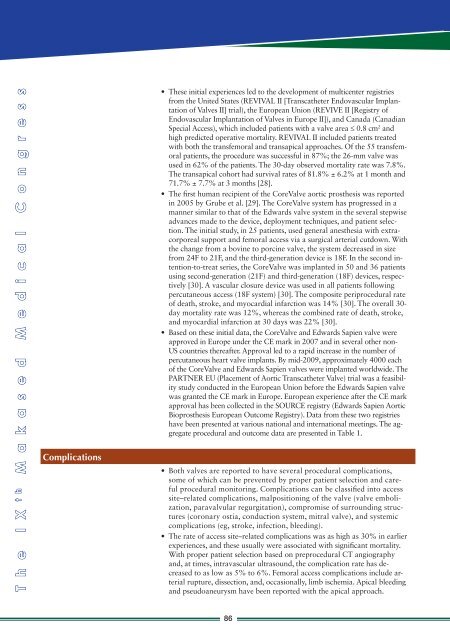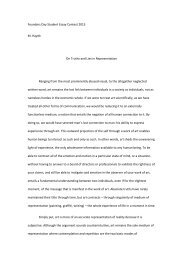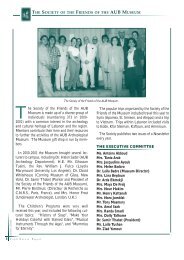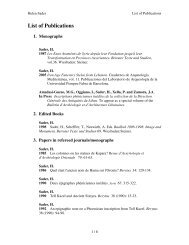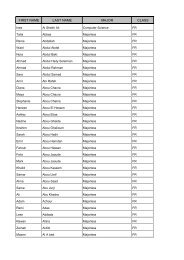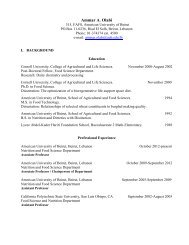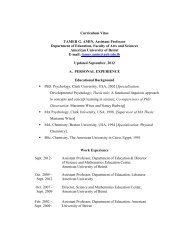The IX t h Makassed Medical Congress - American University of Beirut
The IX t h Makassed Medical Congress - American University of Beirut
The IX t h Makassed Medical Congress - American University of Beirut
Create successful ePaper yourself
Turn your PDF publications into a flip-book with our unique Google optimized e-Paper software.
T h e I X t h M a k a s e d M e d i c a l C o n g r e s s<br />
Complications<br />
Transcatheter Aortic Valve Implantation Kapadia and Tuzcu 471<br />
• <strong>The</strong>se initial experiences led to the development <strong>of</strong> multicenter registries<br />
from the United States (REVIVAL II [Transcatheter Endovascular Implantation<br />
<strong>of</strong> Valves II] trial), the European Union (REVIVE II [Registry <strong>of</strong><br />
Endovascular Implantation <strong>of</strong> Valves in Europe II]), and Canada (Canadian<br />
Special Access), which included patients with a valve area ≤ 0.8 cm 2 and<br />
high predicted operative mortality. REVIVAL II included patients treated<br />
with both the transfemoral and transapical approaches. Of the 55 transfemoral<br />
patients, the procedure was successful in 87%; the 26-mm valve was<br />
used in 62% <strong>of</strong> the patients. <strong>The</strong> 30-day observed mortality rate was 7.8%.<br />
<strong>The</strong> transapical cohort had survival rates <strong>of</strong> 81.8% ± 6.2% at 1 month and<br />
71.7% ± 7.7% at 3 months [28].<br />
• <strong>The</strong> fi rst human recipient <strong>of</strong> the CoreValve aortic prosthesis was reported<br />
in 2005 by Grube et al. [29]. <strong>The</strong> CoreValve system has progressed in a<br />
manner similar to that <strong>of</strong> the Edwards valve system in the several stepwise<br />
advances made to the device, deployment techniques, and patient selection.<br />
<strong>The</strong> initial study, in 25 patients, used general anesthesia with extracorporeal<br />
support and femoral access via a surgical arterial cutdown. With<br />
the change from a bovine to porcine valve, the system decreased in size<br />
from 24F to 21F, and the third-generation device is 18F. In the second intention-to-treat<br />
series, the CoreValve was implanted in 50 and 36 patients<br />
using second-generation (21F) and third-generation (18F) devices, respectively<br />
[30]. A vascular closure device was used in all patients following<br />
percutaneous access (18F system) [30]. <strong>The</strong> composite periprocedural rate<br />
<strong>of</strong> death, stroke, and myocardial infarction was 14% [30]. <strong>The</strong> overall 30day<br />
mortality rate was 12%, whereas the combined rate <strong>of</strong> death, stroke,<br />
and myocardial infarction at 30 days was 22% [30].<br />
• Based on these initial data, the CoreValve and Edwards Sapien valve were<br />
approved in Europe under the CE mark in 2007 and in several other non-<br />
US countries thereafter. Approval led to a rapid increase in the number <strong>of</strong><br />
percutaneous heart valve implants. By mid-2009, approximately 4000 each<br />
<strong>of</strong> the CoreValve and Edwards Sapien valves were implanted worldwide. <strong>The</strong><br />
PARTNER EU (Placement <strong>of</strong> Aortic Transcatheter Valve) trial was a feasibility<br />
study conducted in the European Union before the Edwards Sapien valve<br />
was granted the CE mark in Europe. European experience after the CE mark<br />
approval has been collected in the SOURCE registry (Edwards Sapien Aortic<br />
Bioprosthesis European Outcome Registry). Data from these two registries<br />
have been presented at various national and international meetings. <strong>The</strong> aggregate<br />
procedural and outcome data are presented in Table 1.<br />
• Both valves are reported to have several procedural complications,<br />
some <strong>of</strong> which can be prevented by proper patient selection and careful<br />
procedural monitoring. Complications can be classifi ed into access<br />
site–related complications, malpositioning <strong>of</strong> the valve (valve embolization,<br />
paravalvular regurgitation), compromise <strong>of</strong> surrounding structures<br />
(coronary ostia, conduction system, mitral valve), and systemic<br />
complications (eg, stroke, infection, bleeding).<br />
• <strong>The</strong> rate <strong>of</strong> access site–related complications was as high as 30% in earlier<br />
experiences, and these usually were associated with signifi cant mortality.<br />
With proper patient selection based on preprocedural CT angiography<br />
and, at times, intravascular ultrasound, the complication rate has decreased<br />
to as low as 5% to 6%. Femoral access complications include arterial<br />
rupture, dissection, and, occasionally, limb ischemia. Apical bleeding<br />
and pseudoaneurysm have been reported with the apical approach.<br />
86


